Art & Exhibitions
History’s 20 Greatest Puppy Artworks
Man's best friend can also be the artist's muse.
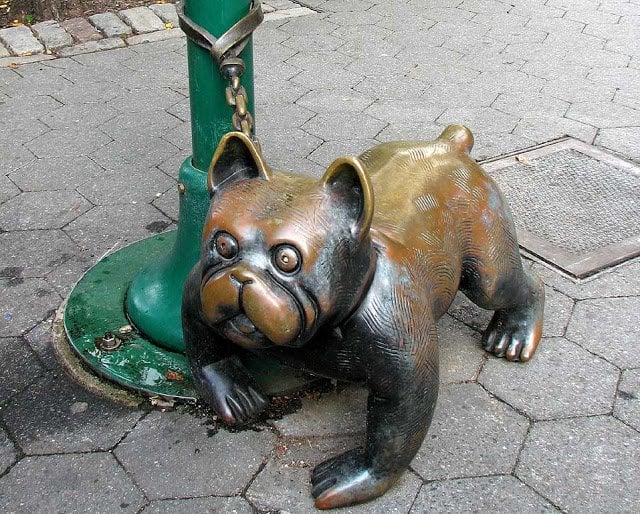
Man's best friend can also be the artist's muse.

Sarah Cascone

Between “The Cat Show” at White Columns, the second edition of the Walker Art Center‘s Internet Cat Video Festival, the Brooklyn Museum‘s homage to the ancient Egyptians’ feline gods, and the Metropolitan Museum‘s cat-themed Balthus retrospective, 2013 was undoubtedly the year of the cat in the art world. But that doesn’t mean man’s best friend isn’t also a popular subject for artists.
The American Kennel Club Museum of the Dog, for instance, opened in St. Louis way back in 1985, and boasts a collection of over 700 dog-themed artworks, while the 2005 tome First Friend: A History of Dogs and Humans primarily cites literary and artistic sources in its efforts to describe the evolving relationship between man and dog, and includes over 20 art historical dog paintings.
Other publications have complied similar roundups. The New York Times marked the 2012 Westminster Kennel Club Dog Show by identifying a sampling of the city’s best dog art, while the Telegraph just published a selection of its favorite dog photos.
Recent exhibitions have also focused on dogs. At last year’s Biennial of the Americas in Denver, the Colorado Symphony put on a performance of “Tragedy on the Sea Nymph: An Operetta in Three Acts” starring an all-dog cast. Beginning next month, the Blanton Museum of Art at the University of Texas in Austin will host “In the Company of Cats & Dogs” (June 22–September 21).
On the occasion of this apparent resurgence of canine art—and after recently delving into the rich history of cat art—artnet News offers this list of our 20 favorite dogs from art history.
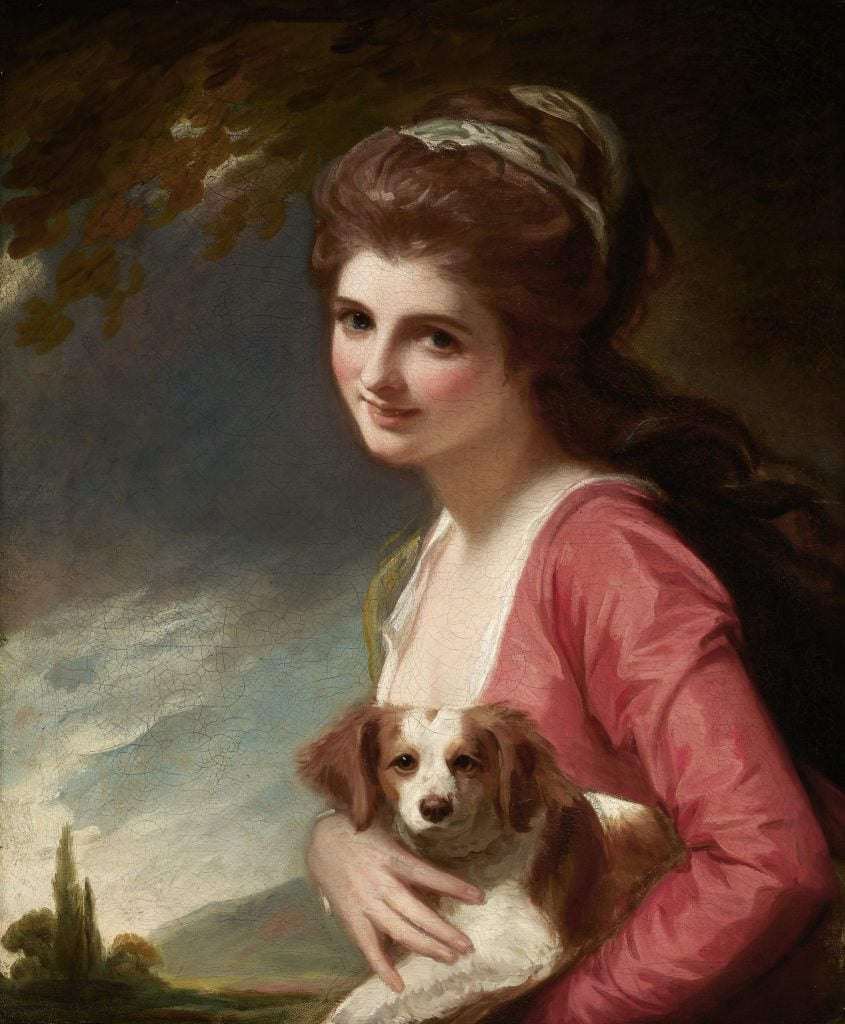
George Romney, Lady Hamilton as Nature (1782). Courtesy the Frick Collection, New York.
1. George Romney, Lady Hamilton as Nature (1782), at the Frick Collection, New York
If you’ve ever listened to the free audio guide for the Frick, you might have taken note of the delightful entry for this portrait, which “depicts an 18th-century superstar at the outset of her career.” Emma Lyon, painted here at 17, apparently rose from her origins as a lowly blacksmith’s daughter to become the mistress of some of Great Britain’s wealthiest men. (Wikipedia claims she was dancing naked on the tables at a week-long stag party at only 15.)
According to the audio guide, her eventual husband, Lord Hamilton, pulled off the original Pygmalion (aka Pretty Woman, for those of you who prefer Julia Roberts to George Bernard Shaw), doing “his best to educate her in music, literature, and social refinement.” Here, though, her lower-class upbringing and scandalous behavior are nowhere in evidence, and she looks every bit the pampered young noblewoman.
Even without the juicy back story, it’s not hard to imagine Emma as a Simple Life–era Paris Hilton, accessorized with a lap dog and an oversize sense of entitlement.
Bonus Fact: what the Frick fails to mention is that George Romney was a first cousin to failed Republican presidential candidate Mitt Romney’s great-great grandfather.
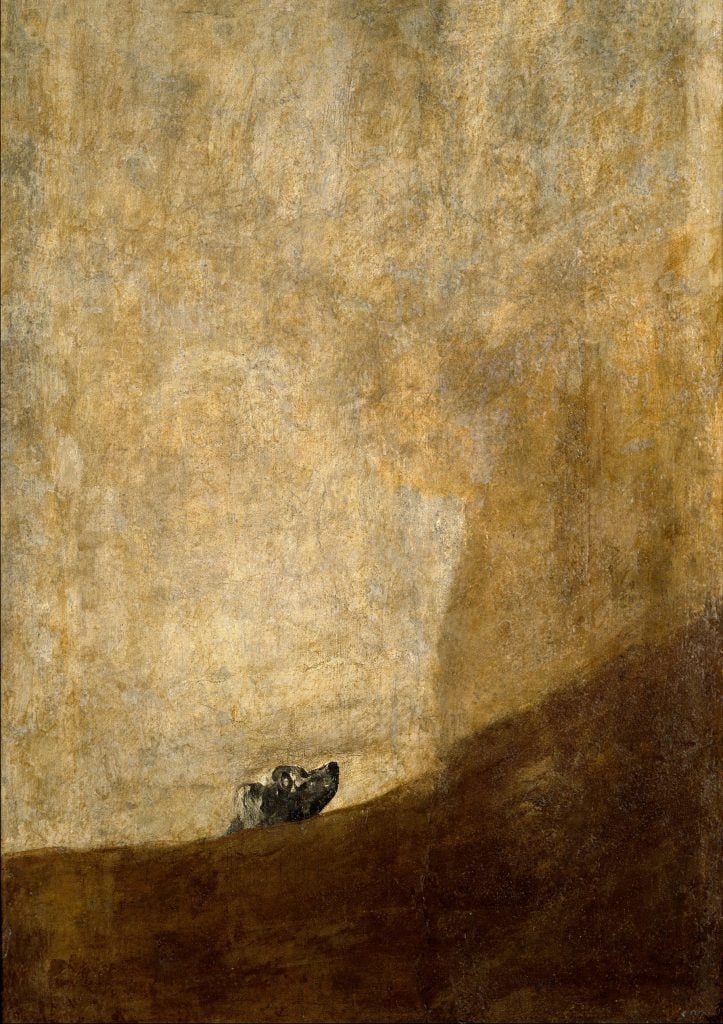
Francisco de Goya, Dog half-submerged (1821–23). Courtesy Museo Nacional del Prado, Madrid.
2. Francisco de Goya, Dog half-submerged (1821–23), at the Museo Nacional del Prado, Madrid
Francisco de Goya’s Dog half-submerged is one of a number of “Black Paintings,” or “la Quinta del Sordo,” that the artist created to decorate his own home. The nightmarish murals are considered quite disturbing, and this one in particular is said to represent the inevitable nature of death.
The dog, glancing nervously upward, grounds an otherwise featureless seascape. Depending on how you look at it, the small creature appears to be sinking deeper and deeper into a dark, quicksand-like mass in the work’s foreground, or to be hiding behind some sort of hill or rock from an unknown predator.

Joan Brown, Noel in the Kitchen (circa 1964).
Courtesy San Francisco Museum of Modern Art.
3. Joan Brown, Noel in the Kitchen (circa 1964), at the San Francisco Museum of Modern Art
Joan Brown, part of the second generation of the Bay Area Figurative movement, is best-known for her autobiographic paintings. This one depicts her son, Noel, toddling about in her kitchen. It’s a surprisingly touching slice of life, completely unpolished and utterly relateable. The floor looks dirty, the counter is piled high with dishes, and, comically, little Noel’s pants are falling down, revealing his bare buttocks as he leans toward the sink.
One imagines that the boy is trying to sneak a treat from the kitchen counter, and that the watchful dogs that tower above him are his partners in crime. Though the painting is now 50 years old, this quietly charming domestic scene has a sense of timelessness about it.
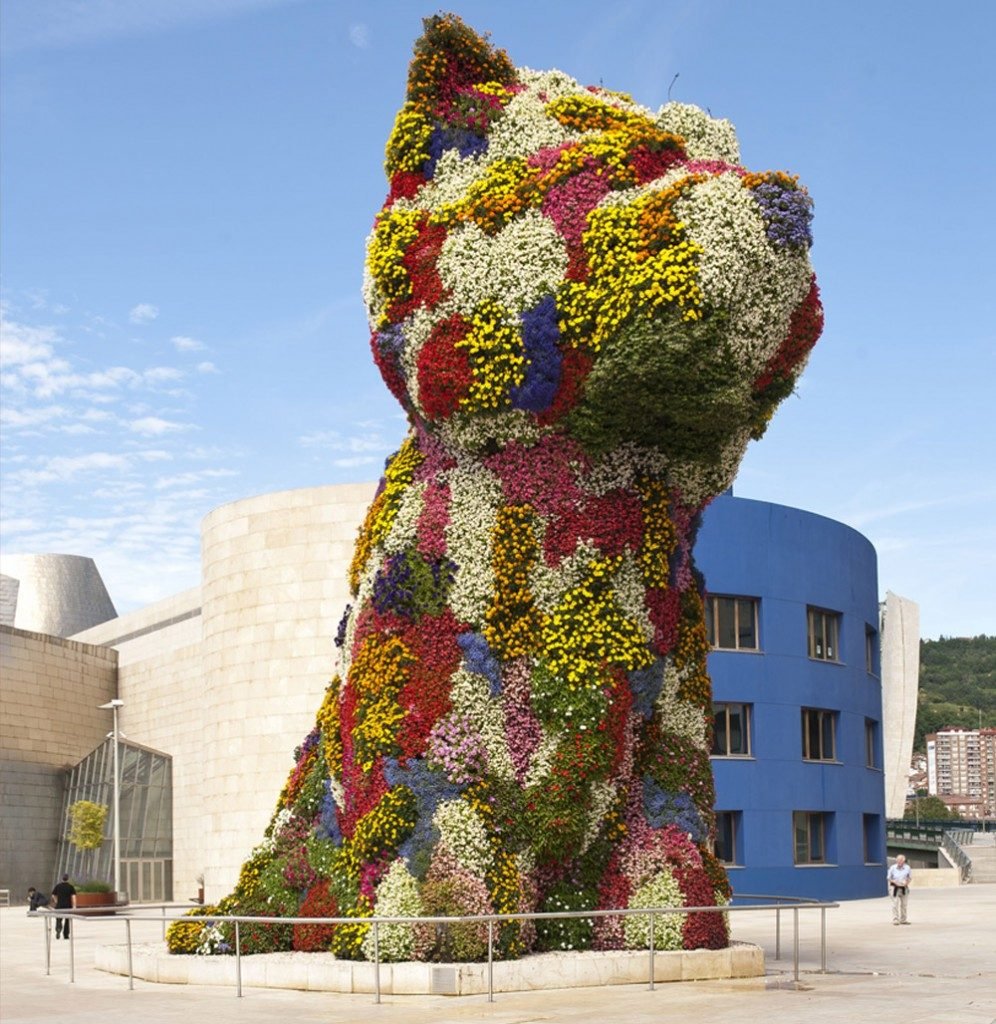
Jeff Koons, Puppy (1992), at Guggenheim Bilbao. Photo courtesy of the Guggenheim Bilbao.
4. Jeff Koons, Puppy (1992), at the Guggenheim Bilbao
Jeff Koons’s iconic flower puppy was first unleashed in Bad Arolsen, Germany, in 1992. Beyond the near-universal appeal of puppies and flowers, the oversize statue simultaneously references the topiary plantings of formal 18th-gardens, dog breeding, and kitschy Chia Pets, and can be understood on multiple levels.
The 43-foot-tall West Highland White Terrier, replete with an internal irrigation system, has since appeared at the Museum of Contemporary Art in Sydney and at New York’s Rockefeller Center. A version is also permanently guarding the entrance to the Guggenheim Bilbao, and another keeps watch over collector Peter Brant’s backyard in Connecticut.
The artist followed up Puppy with his “Balloon Dog” series of giant stainless sculptures (later parodied by Paul McCarthy). In November, Christie’s sold Balloon Dog (Orange) for $58 million, setting the record for sale at auction for a living artist (see report from Bloomberg News).
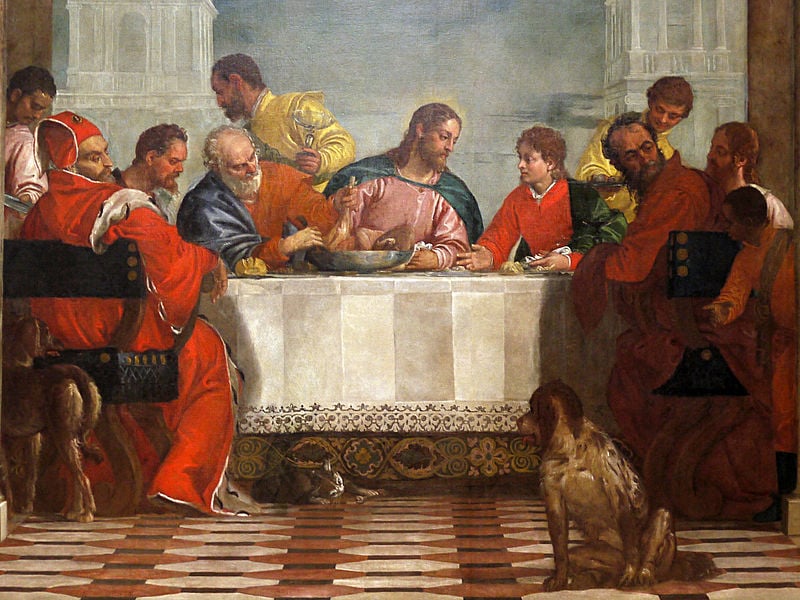
Paolo Veronese, The Feast at the House of Levi, detail, (1573).
Courtesy Gallerie dell’Accademia, Venice.
5. Paolo Veronese, Feast in the House of Levi (1573), at the Gallerie dell’Accademia, Venice
Originally intended as a rendering of the Last Supper, Paolo Veronese’s massive 18-by-42-foot canvas attracted the censure of the Inquisition, when objections were raised over the presence of jesters, little people, drunks, and—god forbid—Germans at the sacred meal. He was called to trial on charges of irreverence and indecorum, and narrowly avoided official accusations for heresy.
A large dog at the foot of the table was also problematic (read the full court transcript at Smart History), even though other artists such as Cosimo Rosselli and Biagio d’Antonio (their Sistine Chapel Last Super also features a dog) somehow got away with the offense. Paul Rubens would later expand on the theme.
Veronese admitted he had already been told to replace the unwelcome animal with Mary Magdalene. “I responded that I would have happily done this and anything else for my sake and the sake of the painting,” he explained, “except that I did not believe that the figure of the Magdalene would look good there, for a variety of reasons, which I can speak to if I am given the chance.”
Earlier this year, the Guardian called Veronese the Ai Weiwei of his day for his utter lack of repentance for his nontraditional rendering of one of the Bible’s most important scenes. Rather than altering the painting, as he ultimately promised, the artist satisfied his critics by simply changing the title.
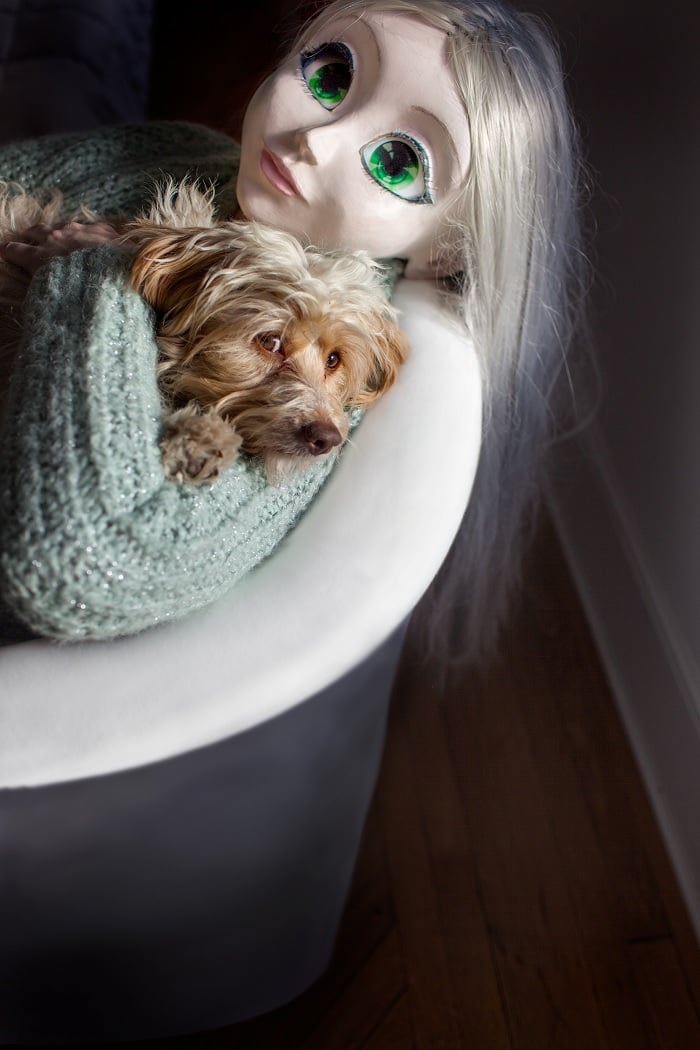
Laurie Simmons, Blonde/Aqua Sweater/Dog (2014).
Courtesy the artist and Salon 94, New York.
6. Laurie Simmons, Blonde/Aqua Sweater/Dog (2014)
That isn’t a life-size puppet in whose arms that adorable little dog is nestling, but a real person, suited up in a head-to-toe latex suit and a custom-designed mask the artist ordered from Russia. Intended for Laurie Simmons’s most recent showing at New York’s Salon 94, the photo is one of a series inspired by the Kigurumi sub-genre of Japanese cosplay.
In a private talk at the gallery, Simmons revealed that the dog, who joined the photo shoot spontaneously, belongs to her daughter. The artist’s family has long been intrigued by the creature’s inquisitive eyes, thinking of the pet as a “human wearing a dog outfit. I want to ask ‘Who’s in there?'”
Says Simmons, “I love to make art historical references that hit you over the head and I thought, ‘a girl and a dog!'” The multiple layers of masks and hidden identities add an intriguing element to the traditional portrait pairing.
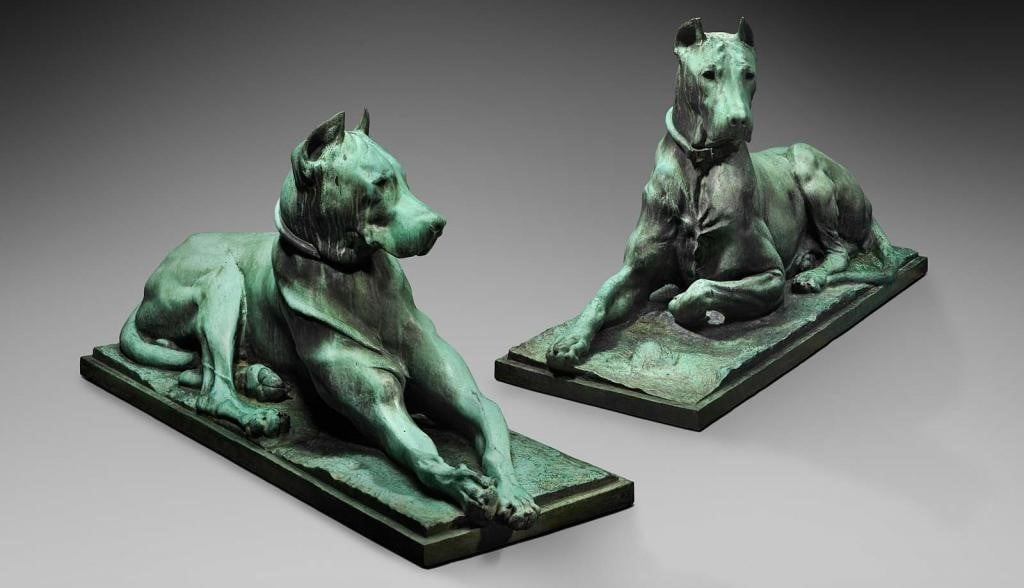
Anna Vaughn Hyatt Huntington, Pair of Great Danes (1907).
Courtesy the Museum of Fine Arts, Boston.
7. Anna Vaughn Hyatt Huntington, Pair of Great Danes (1907), at the Museum of Fine Arts, Boston
In April, as reported by Art Fix Daily, the MFA Boston kicked off a naming contest for these life-size Great Danes, cast in bronze by Boston sculptor Anna Vaughn Hyatt Huntington. The pair currently lounge outside the museum’s Calderwood Courtyard, and visitors were encouraged to submit potential names in a “doggie bowl.”
The contest winner was Carol Robb Blount, Huntington’s grandniece, who suggested honoring the late sculptor by naming her work after her beloved deerhound, Brenda, and Hugo, her Boston Bulldog, who had his own seat at the dining room table and ate out of a china bowl.
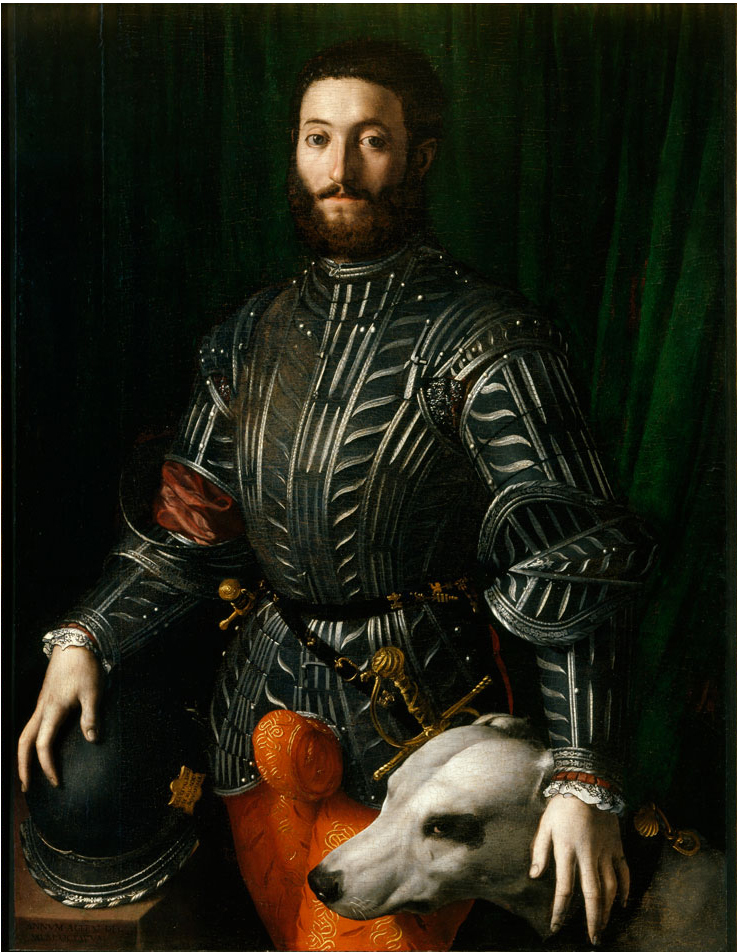
Agnolo Bronzino, Guidobaldo della Rovere (1531–32).
Courtesy Palazzo Pitti, Florence.
8. Agnolo Bronzino, Guidobaldo della Rovere (1531–32), at the Palazzo Pitti, Florence
The juxtaposition of the large dog and the prominent, bright red codpiece in Agnolo Bronzino’s portrait of Guidobaldo della Rovere, duke of Urbino, is awkwardly erotic. Bronzino painted Della Rovere while the teenager was acting as a regent in his father’s absence, and the sexually-charged portrait was likely meant to assert the sitter’s independence and maturity.
The young Della Rovere went on to become an important patron of the arts, commissioning Titian‘s Venus of Urbino (1538), which, come to think of it, also features a dog.

Jean-François Millet, Shepherdess and Her Flock (1862–63).
Courtesy the J. Paul Gerry Museum, Los Angeles.
9. Jean-François Millet, Shepherdess and Her Flock (1862–63), at the J. Paul Gerry Museum, Los Angeles
This peaceful pastoral scene depicts the dog not as friend and companion but as a working animal. Silhouetted against the sky, the animal helps his mistress stand watch over her sheep as nights falls.
Though Jean-François Millet’s depiction of the peasant at work may seem romanticized to modern eyes, the artist was likely hoping to draw attention to the long, arduous hours worked by the shepherdess, and the inherent dignity of such a humble task even in the increasingly industrial world.
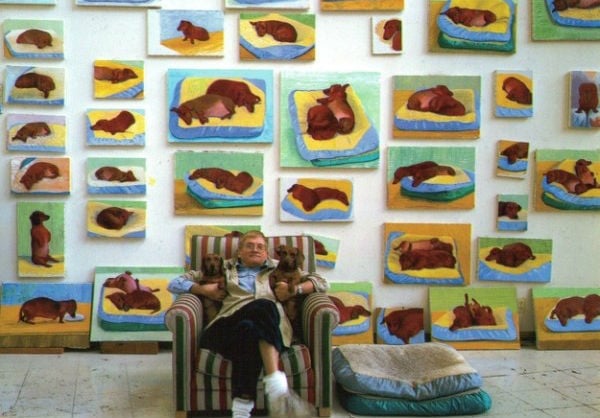
David Hockney and his pet dachshunds Stanley and Boodgie photographed in front of some of the artist’s many artworks based on the dogs. Courtesy of Thames and Hudson.
10. David Hockney, multiple works depicting his dachshunds Stanley and Boodgie
In September 1993, British artist David Hockney turned to his pet dogs, Stanley and Boodgie, for artistic inspiration, setting up canvases all around his house so he would be ready to go to work whenever they plopped down for a nap.
He soon had an impressively large collection of work featuring the animals, which became the basis a 1995 exhibition at the UK’s 1853 Gallery and his 2006 book David Hockney’s Dog Days. “I make no apologies for the apparent subject matter,” the artist wrote. “These two dear little creatures are my friends.”
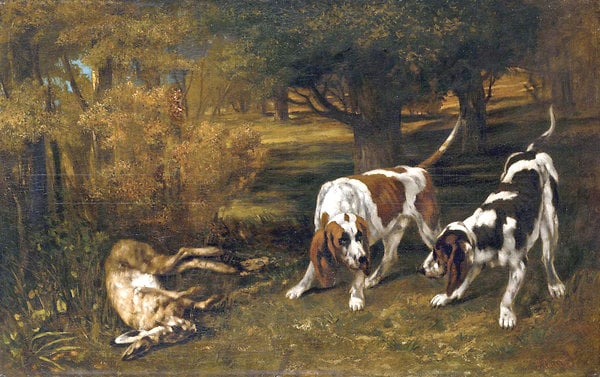
Gustave Courbet, Hunting Dogs With Dead Hare (1857).
Courtesy Metropolitan Museum of Art, New York.
11. Gustave Courbet, Hunting Dogs With Dead Hare (1857), at the Metropolitan Museum of Art, New York.
This painting is just one of many in the Met collection to depict dogs, but it most definitely stands apart. Unlike the cuddly lap dogs and loyal-looking beasts pictured in most canine art, these hunting dogs are undeniably animalistic. Gustave Courbet’s painting reminds us that our beloved pets still may harbor some baser instincts, and that man’s best friend isn’t always so friendly.
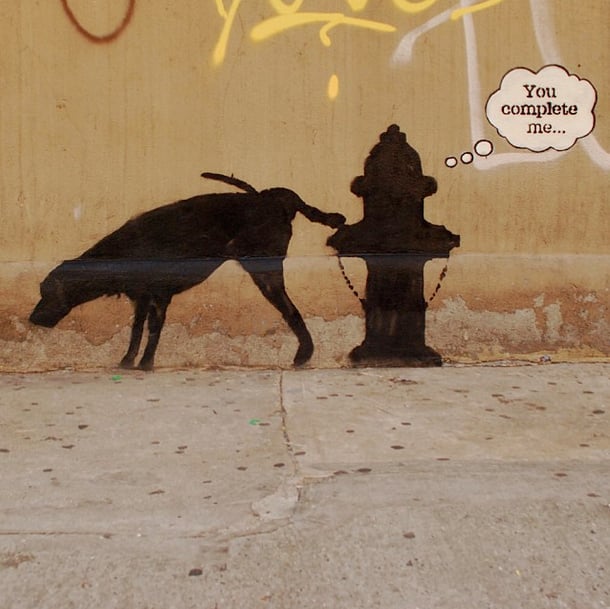
Banksy, You Complete Me (2013), 24th Street and 6th Avenue, New York City. Photo courtesy of the artist.
12. Banksy, You Complete Me (2013), at 24th St and 6th Avenue, New York
The mysterious street artist caused quite a stir during his month-long New York residency last October (see New York magazine‘s guide for a complete round-up of the unauthorized artworks). One of the pieces Bansky left behind in the Big Apple was this indelicate little number implying that hydrants are made for dogs to pee on.
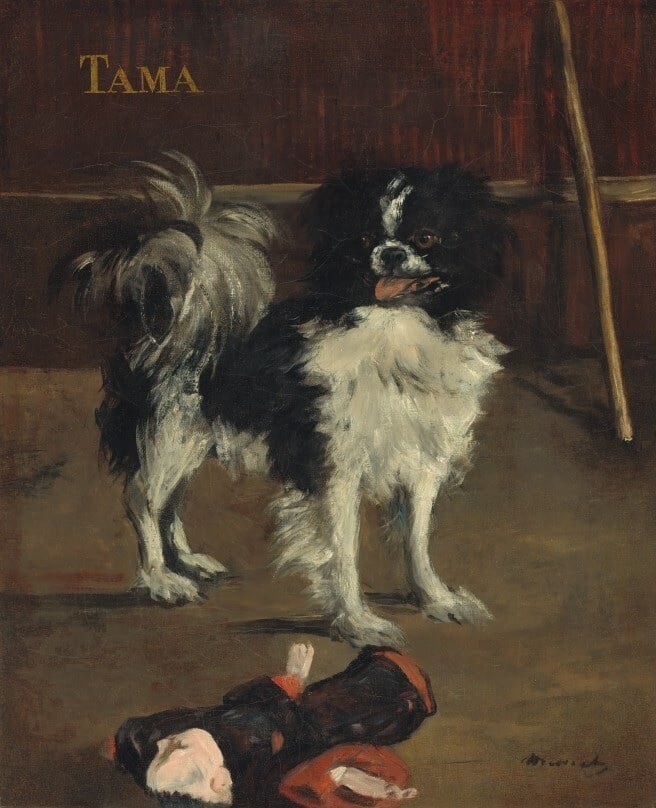
Édouard Manet, Tama, the Japanese Dog (circa 1875).
Photo: courtesy the National Gallery of Art, Washington, DC.
13. Édouard Manet, Tama, the Japanese Dog (circa 1875), at the National Gallery of Art, Washington, DC
Like many of his fellow Impressionists, Édouard Manet was influenced by Japanese art and aesthetics, as evidenced by this painting of a Japanese Chin dog named Tama.
Tama, whose name is the Japanese word for “jewel,” is pictured standing over a Japanese doll. The dog was brought to France by collector Henri Cernuschi, who founded Paris’s Musée Cernuschi to house his extensive collection of Asian art. Not content to have his pet immortalized by just one Impressionist master, Cernuschi had Tama sit for Auguste Renoir as well.

Edward Hopper, Cape Cod Evening (1939).
Courtesy the National Gallery of Art, Washington, DC.
14. Edward Hopper, Cape Cod Evening (1939), at the National Gallery of Art, Washington, DC
This peaceful rural scene depicts a Victorian home on the Massachusetts Cape (a favored area for Edward Hopper, as illustrated in this article from the New York Times). A couple and their collie sit outside the house among the encroaching vegetation, enjoying the day’s end.
The impressive house is at odds with its un-manicured grounds and the rather plain clothes worn by the man and woman, which hint at the contemporaneous Great Depression. According to Hopper, “the dog is listening to something, probably a whippoorwill or some evening sound.”
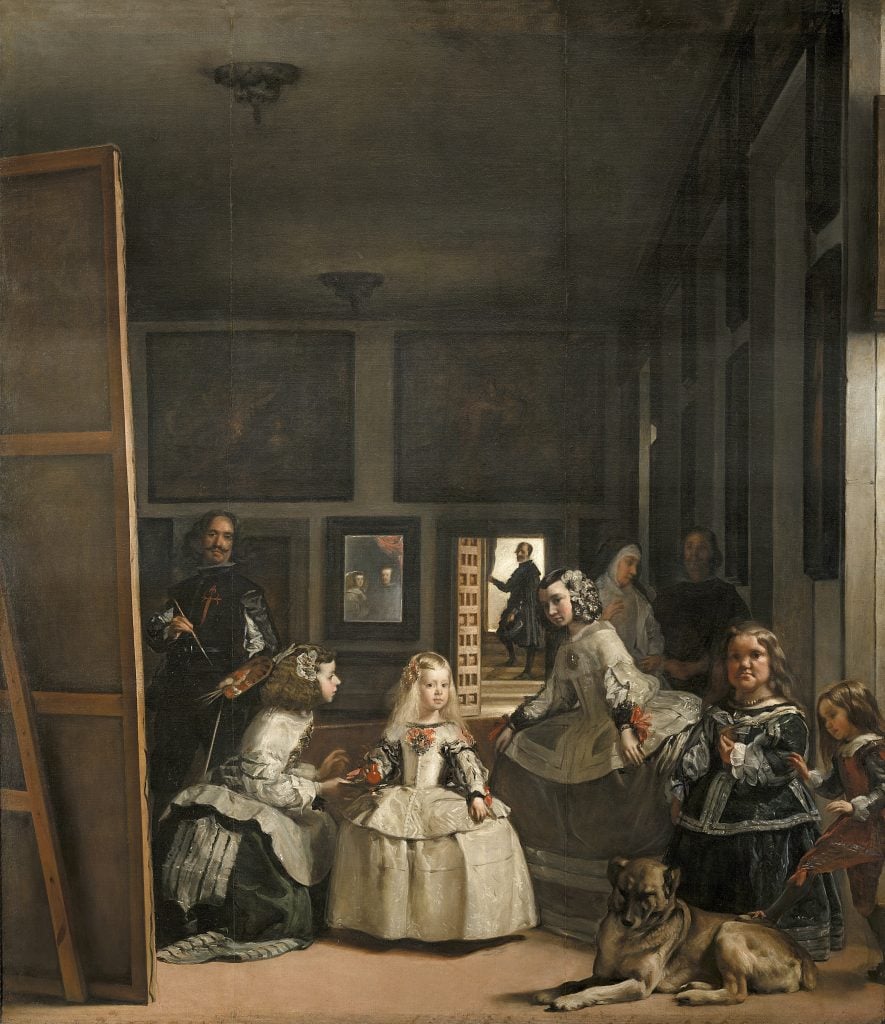
Diego Velázquez, Las Meninas (ca. 1656). Courtesy Museo Nacional del Prado.
15. Diego Velázquez, Las Meninas (circa 1656), at the Museo Nacional del Prado
This group portrait painted by Diego Velázquez of the Spanish court during the reign of King Philip IV includes a colorful cast of characters in the entourage of the young Margaret Theresa of Spain. In addition to her maids of honor, a bodyguard, and the artist himself, a pair of little people on hand for entertainment are also on the scene, one of whom is kicking a large, disgruntled-looking Spanish mastiff. The king and queen are reflected in the mirror on the back wall.
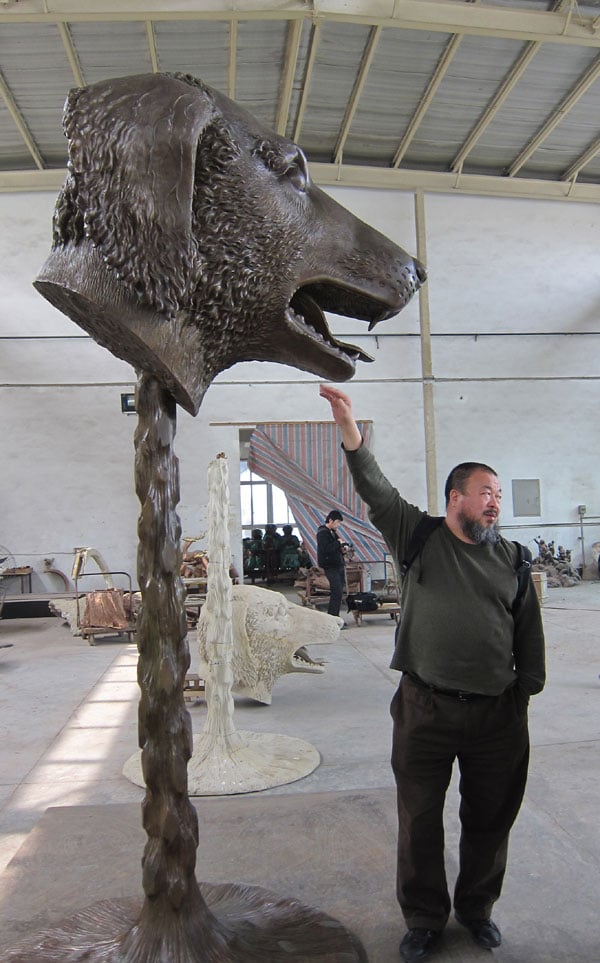
Ai Weiwei pictured with his dog head, part of the installation Circle of Animals/Zodiac Heads (2010).
Photo: courtesy the artist.
16. Ai Weiwei, Dog, from “Circle of Animals/Zodiac Heads” (2010)
During the dissident artist’s much-publicized 2011 detention at the hands of the Chinese government, Ai Weiwei continued to show his work abroad. Circle of Animals became the first major public sculpture by the artist, with installations in New York outside the Plaza Hotel, as well as in London, Los Angeles, Houston, and other cities.
A series of 12 four-foot-tall bronze animal heads—one for each sign of the Chinese zodiac—atop a narrow pedestal, Circle of Animals is based on 18th century sculptures created by Jesuits for a fountain clock in Beijing’s Summer Palace for the Manchu emperor Qianlong. In 1860, during the Second Opium War, the Summer Place was looted and the heads stolen by British and French troops. Seven have since been recovered, but Ai was forced to imagine what the original dog would have looked like.
According to the Art Newspaper, the Zodiac Heads will travel to the Museo Nacional de Antropología, Mexico City, in June.
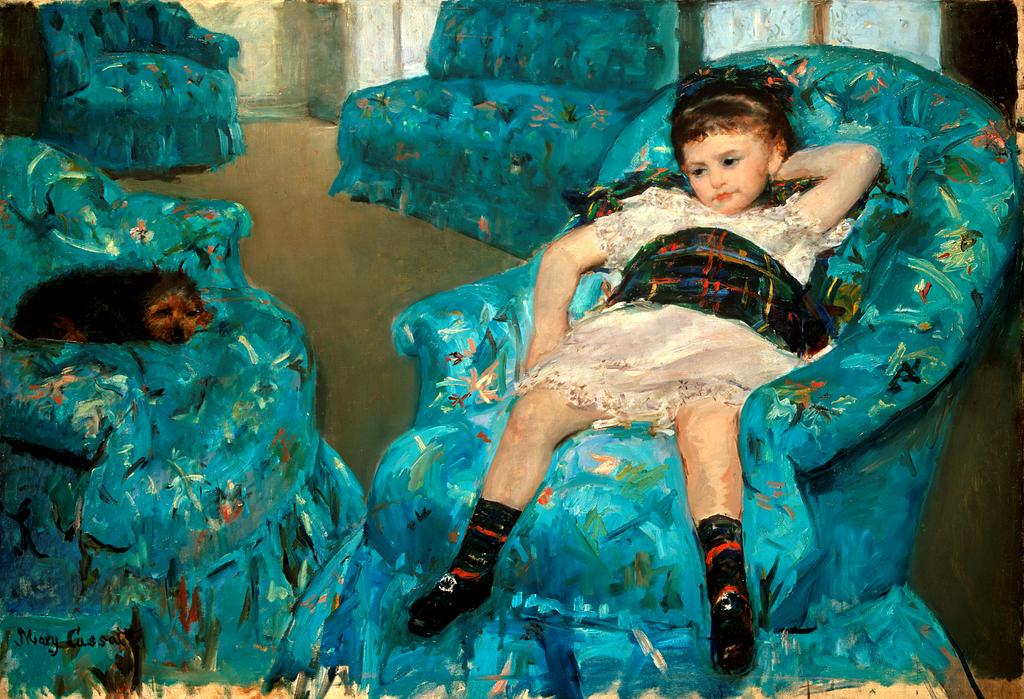
Mary Cassatt, Little Girl in a Blue Armchair (1878).
Courtesy National Gallery of Art, Washington, DC.
17. Mary Cassatt, Little Girl in a Blue Armchair (1878), at the National Gallery of Art, Washington, DC
Mary Cassatt painted this portrait in anticipation of joining her first Impressionist Exhibition in 1878. Although the exhibition was postponed to avoid competing with the World’s Fair, this painting of a bored little girl and a sleepy Brussels Griffon (thought to have been a gift from Edgar Degas) was a radical departure from traditional formal portraits of children. Cassatt made her triumphant Impressionist debut the following year with a full room of her works—among them, art historians believe, her Little Girl in a Blue Armchair.

Charles Willson Peale, The Peale Family (1773–1809).
Photo: courtesy the New York Historical Society.
18. Charles Willson Peale, The Peale Family (1773–1809), at the New York Historical Society
An important early American painter, Charles Willson Peale created this ambitious work to demonstrate his prowess in portraiture—as a sort of advertisement, if you will. The painting shows Peale, his family, and the tools of his trade. The family dog, Argus—named for Odysseus’s loyal pet in Homer’s Odyssey—was actually a later addition to the piece. Painted in some 35 years later, Argus signifies the importance of fidelity, completing a series of classical allusions in the scene that also include learning and grace.
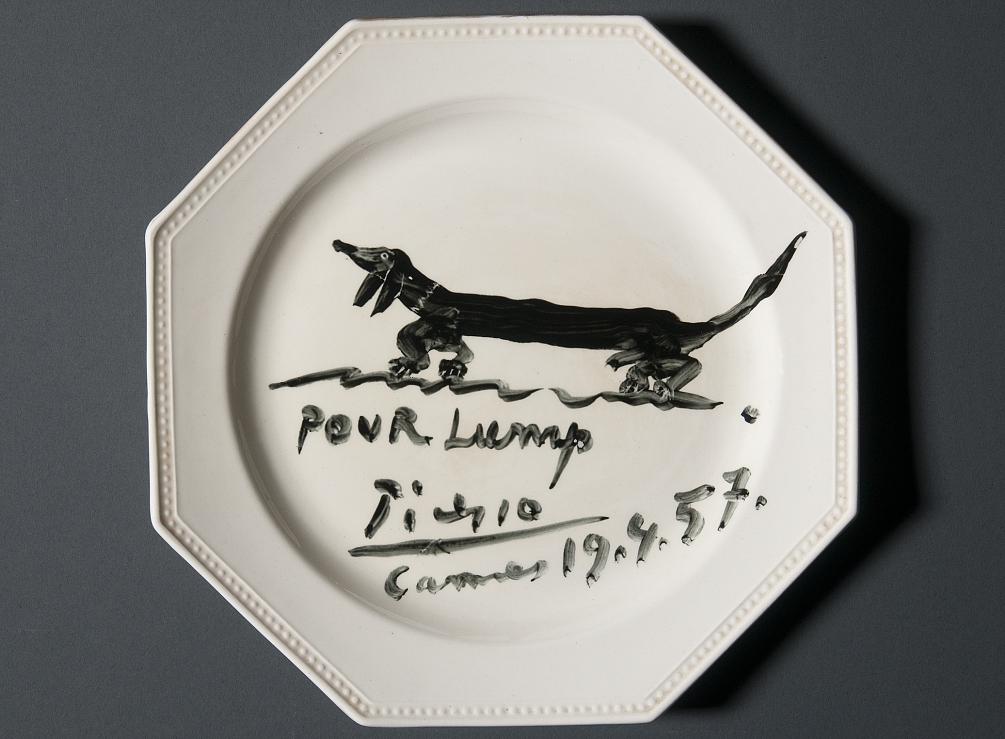
Pablo Picasso, souvenir luncheon plate dedicated to Lump, David Douglas Duncan’s dachshund (1957). Photo by Pete Smith, courtesy of the University of Texas at Austin.
19. Pablo Picasso, dinner plate portrait of Lump the dog (1957)
The artist’s intimate relationships with his female models are well known, but Pablo Picasso also had a less infamous canine muse: a dachshund named Lump who was basically kidnapped from Life photographer David Douglas Duncan.
Upon their first meeting during Duncan’s 1957 stay at Picasso’s home, the artist was immediately taken by the Lump, painting this impromptu portrait (see article from the New York Times). Some months later, as man and dog prepared to depart, Picasso allegedly told the photographer “You will leave him, of course?”
The dog, who stayed the with artist for six years, figures prominently in 15 of Picasso’s “Las Meninas” paintings, (based on the aforementioned Velázquez masterpiece) and was the subject of Duncan’s book Picasso and Lump: A Dachshund’s Odyssey (2006). Lump and Picasso died within 10 days of each other in 1973.

George W. Bush with some fresh dog paintings.
Video still via Fox Atlanta.
20. George W. Bush, assorted paintings of dogs
Let’s not forget that before he debuted his series of Wikipedia-sourced portraits of world leaders, George W. Bush got his start as an artist painting dogs—no fewer than 50 of them, according to an interview W.’s teacher, Bonnie Flood, gave to Fox Atlanta.
They didn’t quite capture the public’s interest the way that the former president’s self-portrait in the bathtub did, but they did help pave the way for Bush’s recent “The Art of Leadership” exhibit at the the George W. Bush Presidential Library and Museum in Dallas.

Tom Otterness, The Real World, detail (1992), Nelson Rockefeller State Park, Battery Park City, New York. Courtesy of the New York City Parks Department.
Worst Dog Artwork: Tom Otterness‘s Shot Dog Video (1977)
This film by the master of cute bronzes shows exactly what the title says. In the words of artist and critic Gary Indiana, describing the piece in a 2004 interview with New York magazine: “Mr. Otterness, once upon a time, adopted a dog and then shot it to death for the fun of recording his infantile, sadistic depravity on film.”
The piece attracted little attention at the time, but Otterness has come under fire from animal rights activists in the years since. He finally issued an apology in 2007, saying that the film was “an indefensible act that I am deeply sorry for.” Since shooting the offending video, Otterness has incorporated dogs into his work in less violent ways, as seen above.